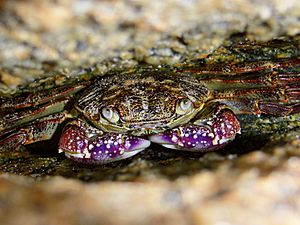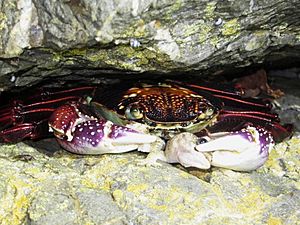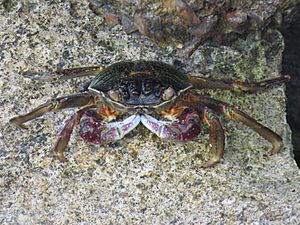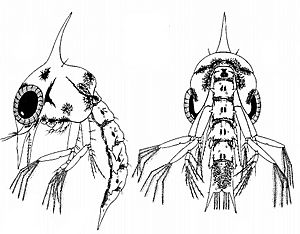Leptograpsus facts for kids
Quick facts for kids Leptograpsus variegatus |
|
|---|---|
 |
|
| Scientific classification | |
| Kingdom: | |
| Phylum: | |
| Subphylum: | |
| Class: | |
| Order: | |
| Infraorder: | |
| Family: |
Grapsidae
|
| Genus: |
Leptograpsus
H. Milne-Edwards, 1853
|
| Species: |
L. variegatus
|
| Binomial name | |
| Leptograpsus variegatus (Fabricius, 1793)
|
|
The purple rock crab, officially named Leptograpsus variegatus, is a cool crab that lives in the ocean. It's part of the Grapsidae family, which includes many types of shore crabs. You can find these crabs in the warmer, southern parts of the Indo-Pacific Ocean. They can grow to have a shell about 50 millimeters (2 inches) wide. This crab is special because it's the only known species in its group, called the Leptograpsus genus.
Contents
Understanding the Purple Rock Crab's Name
The way scientists name living things is called taxonomy. It helps them organize and understand all the different species on Earth.
How the Purple Rock Crab Got Its Name
The purple rock crab was first described in 1793. Back then, it was given the name Cancer variegatus. Later, in 1803, it was moved to a different group and called Graspus variegatus.
Over the years, this crab was described by different scientists multiple times. They gave it new names like Grapsus personatus and Grapsus strigilatus. But in 1853, a scientist named Henri Milne-Edwards created a new group, or genus, just for this crab. He named the genus Leptograpsus. He realized that all those other names were actually for the same crab. So, Graspus variegatus became the main example for the new Leptograpsus genus.
What Does the Purple Rock Crab Look Like?
Purple rock crabs are quite large. Their main body shell, called a carapace, can be up to 50 millimeters (about 2 inches) wide. When they are grown up, they usually have a purple color. They might also have some white patterns on their shell.
Younger crabs, called juveniles, look a bit different. They are usually bluish-grey with black patterns. The crab's carapace is somewhat square-shaped. Their eyes are not very long. The crab's body is smooth and doesn't have any hairs.
Purple Rock Crab Eggs and Larvae
When a female crab lays eggs, they are very tiny, about 0.36 millimeters across. They start out a very dark brown color. As the eggs get closer to hatching, they grow a little bigger, to about 0.44 x 0.42 millimeters. At this stage, they turn a lighter brown.
After hatching, the baby crabs are called zoea. The first zoea of the purple rock crab are about 1.31 millimeters long.
Where Do Purple Rock Crabs Live?
Purple rock crabs are found in several places around the world. You can spot them in Australia, from the western to the southern coasts. They also live along the coast of South America, from Peru down to Chile. You'll find them in New Zealand and on many islands in the Pacific Ocean.
These crabs prefer to live in rocky areas along the coast. This is the part of the shore that is covered by water at high tide and exposed to the air at low tide. You can often see them quickly running across exposed rocks. They also like to hide in small cracks or under big boulders to stay safe.
Purple Rock Crab Life Cycle and Reproduction
Female purple rock crabs are known to carry their eggs mainly during December. They keep the eggs safe under their bodies. The female crab will incubate, or hold and protect, her eggs for about six weeks until they are ready to hatch.
What Do Purple Rock Crabs Eat?
The purple rock crab is an omnivore. This means it eats both plants and animals. They have a wide variety of foods they enjoy.
Hunting for Food
These crabs often eat algae that grows on rocks, like Corallina and Ulva lactuca (sea lettuce). But they also hunt for animals. They have been seen eating barnacles and limpets. Barnacles are small shellfish that stick to rocks, and limpets are small, cone-shaped snails.
When a purple rock crab wants to catch a limpet, it waits for the limpet to start moving. Then, the crab quickly uses its strong claws, called chelae, to get under the limpet's shell. Once it's under, it flips the limpet over to eat it.
Interestingly, there's even one observation of a purple rock crab eating a Raukawa gecko. This gecko is a type of lizard that lives in New Zealand.

See also
 In Spanish: Jaiba corredora para niños
In Spanish: Jaiba corredora para niños



